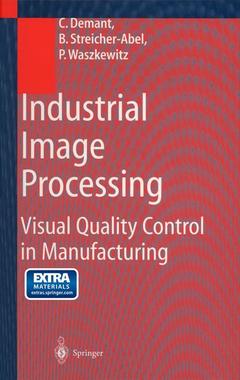1. Introduction.- 1.1 Why write another book about image processing?.- 1.2 Possibilities and limitations.- 1.3 Types of inspection tasks.- 1.4 Structure of image processing systems.- 1.4.1 Hardware setup.- 1.4.2 Signal flow in the process environment.- 1.4.3 Signal flow within an image processing system.- 1.5 Solution approach.- 1.6 Introductory example.- 1.6.1 Character recognition.- 1.6.2 Thread depth.- 1.6.3 Presence verification.- 1.7 From here.- 2. Overview: Image Preprocessing.- 2.1 Gray scale transformations.- 2.1.1 Look-up tables.- 2.1.2 Linear gray level scaling.- 2.1.3 Contrast enhancement.- 2.1.4 Histogram equalization.- 2.1.5 Local contrast enhancement.- 2.2 Image arithmetic.- 2.2.1 Image addition and averaging.- 2.2.2 Image subtraction.- 2.2.3 Minimum and maximum of two images.- 2.2.4 Shading correction.- 2.3 Linear filters.- 2.3.1 Local operations and neighborhoods.- 2.3.2 Principle of linear filters.- 2.3.3 Smoothing filter.- 2.3.4 Edge filters.- 2.4 Median filter.- 2.5 Morphological filters.- 2.6 Other non-linear filters.- 2.7 Global operations.- 2.8 Key terms.- 3. Positioning.- 3.1 Position of an individual object.- 3.1.1 Positioning using the entire object.- 3.1.2 Positioning using an edge.- 3.2 Orientation of an individual object.- 3.2.1 Orientation computation using principal axis.- 3.2.2 Distance-versus-angle signature.- 3.3 Robot positioning.- 3.3.1 Setting of tasks.- 3.3.2 Image processing components.- 3.3.3 Position determination on one object.- 3.3.4 Orientation of an object configuration.- 3.3.5 Comments concerning position adjustment.- 3.4 Key terms.- 4. Overview: Segmentation.- 4.1 Regions of interest.- 4.1.1 Regions and objects.- 4.2 Thresholding.- 4.2.1 Thresholds.- 4.2.2 Threshold determination from histogram analysis.- 4.2.3 Gray level histograms.- 4.2.4 Generalizations of thresholding.- 4.3 Contour tracing.- 4.3.1 Pixel connectedness.- 4.3.2 Generating object contours.- 4.3.3 Contour representation.- 4.4 Edge based methods.- 4.4.1 Edge probing in industrial image scenes.- 4.4.2 Edge detection with subpixel accuracy.- 4.5 Template matching.- 4.5.1 Basic operation.- 4.5.2 Optimizing template matching.- 4.5.3 Comments on template matching.- 4.6 Key terms.- 5. Mark Identification.- 5.1 Bar code identification.- 5.1.1 Principle of gray-level-based bar code identification.- 5.1.2 Bar code symbologies.- 5.1.3 Examples of industrial bar code identification.- 5.1.4 Further information.- 5.2 Character recognition.- 5.2.1 Laser-etched characters on an IC.- 5.2.2 Basic configuration of the character recognition.- 5.2.3 Fundamental structure of a classifier application.- 5.2.4 Position adjustment on the IC.- 5.2.5 Improving character quality.- 5.2.6 Optimization in operation.- 5.3 Recognition of pin-marked digits on metal.- 5.3.1 Illumination.- 5.3.2 Preprocessing.- 5.3.3 Segmentation and classification.- 5.4 Block codes on rolls of film.- 5.5 Print quality inspection.- 5.5.1 Procedure.- 5.5.2 Print quality inspection in individual regions.- 5.5.3 Print quality inspection with automatic subdivision.- 5.6 Key terms.- 6. Overview: Classification.- 6.1 What is classification?.- 6.2 Classification as function approximation.- 6.2.1 Machine learning.- 6.2.2 Statistical foundations.- 6.2.3 Constructing classifiers.- 6.3 Instance-based classifiers.- 6.3.1 Nearest neighbor classifier.- 6.3.2 RCE networks.- 6.3.3 Radial basis functions.- 6.3.4 Vector quantization.- 6.3.5 Template matching.- 6.3.6 Remarks on instance-based classifiers.- 6.4 Function-based classifiers.- 6.4.1 Polynomial classifier.- 6.4.2 Multilayer perceptron-type neural networks.- 6.4.3 Representation of other classifiers as neural networks.- 6.5 Remarks on the application of neural networks.- 6.5.1 Composition of the training set.- 6.5.2 Feature scaling.- 6.5.3 Rejection.- 6.5.4 Arbitrariness.- 6.6 Key terms.- 7. Dimensional Checking.- 7.1 Gauging tasks.- 7.2 Simple gauging.- 7.2.1 Center point distance.- 7.2.2 Contour distances.- 7.2.3 Angle measurements.- 7.3 Shape checking on a punched part.- 7.3.1 Inspection task.- 7.3.2 Modeling contours by lines.- 7.3.3 Measuring the contour angle.- 7.4 Angle gauging on toothed belt.- 7.4.1 Illumination setup.- 7.4.2 Edge creation.- 7.5 Shape checking on injection-molded part.- 7.5.1 Computing radii.- 7.5.2 Remarks on model circle computation.- 7.6 High accuracy gauging on thread flange.- 7.6.1 Illumination and image capture.- 7.6.2 Subpixel-accurate gauging of the thread depth.- 7.7 Calibration.- 7.7.1 Calibration mode.- 7.7.2 Inspection-related calibration.- 7.8 Key terms.- 8. Overview: Image Acquisition and Illumination.- 8.1 Solid-state sensors.- 8.1.1 CCD sensor operation.- 8.1.2 Properties of CCD sensors.- 8.1.3 Image degradation.- 8.2 Standard video cameras.- 8.2.1 Basic structure.- 8.2.2 The video standard.- 8.2.3 Sampling of the line signal.- 8.2.4 Extensions of the video standard.- 8.2.5 Image quality.- 8.3 Other camera types.- 8.3.1 Progressive scan cameras.- 8.3.2 Asynchronous cameras.- 8.3.3 Digital cameras.- 8.3.4 Line-scan cameras.- 8.3.5 Additional camera properties.- 8.4 Transmission to the computer.- 8.4.1 Basic operation of a frame grabber.- 8.4.2 Frame grabbers for standard video cameras.- 8.4.3 Frame grabbers for other camera types.- 8.4.4 Direct digital transmission.- 8.5 Optical foundations.- 8.5.1 F-number.- 8.5.2 Thin lens imaging equation.- 8.5.3 Depth of field.- 8.5.4 Typical imaging situations.- 8.5.5 Aberrations.- 8.5.6 Lens selection.- 8.5.7 Special optical devices.- 8.6 Illumination technology.- 8.6.1 Light sources.- 8.6.2 Front lighting.- 8.6.3 Back Lighting.- 8.7 Key terms.- 9. Presence Verification.- 9.1 Simple presence verification.- 9.1.1 Part geometry.- 9.1.2 Illumination.- 9.1.3 Position adjustment.- 9.1.4 Segmentation.- 9.1.5 Evaluation.- 9.1.6 Segmentation with template matching.- 9.2 Simple gauging for assembly verification.- 9.2.1 Illumination.- 9.2.2 Inspection criteria.- 9.2.3 Object creation and measurement computation.- 9.2.4 Position adjustment.- 9.3 Presence verification using classifiers.- 9.3.1 Illumination.- 9.3.2 Inspection of the caulking.- 9.3.3 Type verification of the flange.- 9.4 Contrast-free presence verification.- 9.5 Key terms.- 10. Overview: Object Features.- 10.1 Basic geometrical features.- 10.1.1 Enclosing rectangle.- 10.1.2 Area and perimeter.- 10.1.3 Center of gravity.- 10.1.4 Axes and radii.- 10.2 Shape-descriptors.- 10.2.1 Curvature.- 10.2.2 Fiber features.- 10.2.3 Euler’s number.- 10.2.4 Moments and Fourier descriptors.- 10.3 Gray level features.- 10.3.1 First-order statistics.- 10.3.2 Texture features.- 10.4 Key terms.- 11. Outlook: Visual Inspection Projects.- A. Mathematical Notes.- A.1 Backpropagation training.- A.1.1 Neural networks — concept and history.- A.1.2 Fundamentals.- A.1.3 Backpropagation.- A.2 Computation of the depth of field.- A.2.1 Limit distances.- A.2.2 Depth of field at infinite distance.- A.2.3 Dependence of the depth of field on the focal length.- B. The Companion CD.- References.




